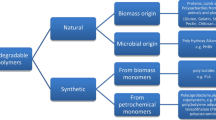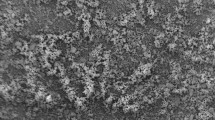Abstract
The poly(3-hydroxybutyrate-co-3-hydroxyvalerate) (PHBV) was used to prepare biocompatible composites modified by the hemp fibers. The aim of the study was to assess the structure and selected thermal and mechanical properties of the obtained biocomposites. The morphology of samples was analyzed using a scanning electron microscope and a computed tomography analysis. The phase transitions of composites and polymer matrix were investigated using differential scanning calorimetry. Moreover, the non-equilibrium and equilibrium thermal parameters of composites and the unfilled PHBV were established based on the thermal history. Knowing equilibrium parameters, i.e., the heat of fusion for the fully crystalline materials, ΔHf (100%), and the change of heat capacity at glass transition temperature (Tg) for the fully amorphous, ΔCp (100%), composites, the degree of crystallinity, mobile, and rigid amorphous fractions were estimated. The addition of hemp fibers to the PHBV matrix caused around a two-time increase in the degree of crystallinity in reference to the unfilled PHBV. It was also observed that the addition of hemp fibers caused a decrease in heat capacity for fully amorphous material for all the biocomposites obtained. A similar relationship was observed in case of values of the heat of fusion for fully crystalline material. Simultaneously, the decrease in amorphous phase contents was noted. It was also noted that the rigid amorphous fraction exists only for the unfilled polymer matrix. Some mechanical properties of investigated materials were also measured and presented.













Similar content being viewed by others
References
Netravali AN, Chabba S. Composites get greener. Materials today, Elsevier. 2003;6:22–9.
Terzopouloua Z, Papageorgioua G, Papadopouloub E, Athanassiadoub E, Alexopoulouc E, Bikiarisa D. Green composites prepared from aliphatic polyesters and bast fibers. Ind Crop Prod. 2015;68:60–79.
Joseph K, Varghese S, Kalaprasad G, Thomas S, Prasannakumari L, Koshy P, Pavithran C. Influence of interfacial adhesion on the mechanical properties and fracture behaviour of short sisal fibre reinforced polymer composites. Eur Polym. 1996;32:1243–50.
Joseph PV, Mathew G, Joseph K, Thomas S, Pradeep P. Mechanical properties of short sisal fiber-reinforced polypropylene composites: comparison of experimental data with theoretical predictions. J Appl Polym Sci. 2003;88:602–11.
Ouajai S, Shanks RA. Composition, structure and thermal degradation of hemp cellulose after chemical treatments. Polym Degrad Stabil. 2005;89:327–35.
Suardana NPG, Piao Y, Lim JK. Mechanical properties of hemp fibers and hemp/pp composites: effects of chemical surface treatment. Mater Phys Mech. 2011;11:1–8.
Le TM, Pickering KL. The potential of harakeke fibre as reinforcement in polymer matrix composites including modelling of long harakeke fibre composite strength. Compos Part A-Appl Sci Manuf. 2015;76:44–53.
Beckermann G. Performance of hemp-fibre reinforced polypropylene composite materials, PhD Dissertation, The University of Waikato, 2007.
Madsen B, Thygesen A, Lilholt H. Plant fibre composites–porosity and stiffness. Compos Sci Technol. 2009;69:1057–69.
Madsen B, Lilholt H. Physical and mechanical properties of unidirectional plant fibre composites - an evaluation of the influence of porosity. Compos Sci Technol. 2003;63:1265–72.
Niska KO, Sain M. Wood-polymer composites. Amsterdam: Elsevier; 2008.
Roumeli E, Terzopoulou Z, Pavlidou E, Chrissafis K, Papadopoulou E, Athanasiadou E, Bikiaris DN. Effect of maleic anhydride on the mechanical and thermal properties of hemp/high-density polyethylene green composites. J Therm Anal Calorim. 2015;121:93–105.
Khoathane MC, Vorster OC, Sadiku ER. Hemp fiber-reinforced 1-pentene/polypropylene copolymer: the effect of fiber loading on the mechanical and thermal characteristics of the composites. J Reinf Plast Comp. 2008;27:1533–44.
Terzopoulou ZN, Papageorgiou GZ, Papadopoulou E, Athanassiadou E, Alexopoulou E, Bikiaris DN. Green composites prepared from aliphatic polyesters and bast fibers. Ind Crops Prod. 2015;68:60–79.
Terzopoulou ZN, Papageorgiou GZ, Papadopoulou E, Athanassiadou E, Reinders M, Bikiaris DN. Development and study of fully biodegradable composite materials based on poly (butylene succinate) and hemp fibers or hemp shives. Polym Compos. 2016;37:407–21.
Faruk O, Bledzki AK, Fink HP, Sain M. Biocomposites reinforced with natural fibers: 2000–2010. Prog Polym Sci. 2012;37:1552–96.
Kelly A, Tyson AW. Tensile properties of fibre-reinforced metals: copper/tungsten and copper/molybdenum. J Mech Phys Solids. 1965;13:329–50.
Scholz C. Poly(13-hydroxyalkanoates) as potential biomedical materials: an overview, polymers from renewable resources, ACS symposium series. Am Chem Soc Washington, DC. 2001;21:328–34.
Białkowska A, Bakar M, Przybyłek M. Effect of nonisocyanate polyurethane and nanoclay on the mechanical properties of an epoxy resin. Mech Compos Mater. 2018;54:665–74.
Białkowska A, Mucha K, Przybyłek M, Bakar M. Effect of hard segments content on the properties, structure and biodegradation of nonisocyanate polyurethane. Polym Polym Compos. 2018;26:423–30.
Beun JJ, Dircks K, Van Loosdrecht MCM, Heijnen JJ. Poly-β-hydroxybutyrate metabolism in dynamically fed mixed microbial cultures. Water Res. 2002;36:1167–80.
Serafim LS, Lemos PC, Albuquerque MG, Reis MA. Strategies for PHA production by mixed cultures and renewable waste materials. Appl Microbiol Biotechnol. 2008;81:615–28.
Beccari M, Bertin L, Dionisi D, Fava F, Lampis S, Majone M, Valentino F, Vallini G, Villano M. Exploiting olive oil mill effluents as a renewable resource for production of biodegradable polymers through a combined anaerobic–aerobic process. J Chem Technol Biotechnol. 2009;84:901–8.
Albuquerque MGE, Martino V, Pollet E, Avérous L, Reis MAM. Mixed culture poly-hydroxyalkanoate (PHA) production from volatile fatty acid (VFA)-rich streams: effect of substrate composition and feeding regime on PHA productivity, composition and properties. J Biotechnol. 2011;151:66–76.
Zarzyka-Niemiec I. Reaction pathway and product analysis for hydroxyalkylation of urea and N, N-Bis(2-hydroxypropyl)urea with propylene carbonate. J Appl Polym. 2008;110:3917–25.
Zarzyka-Niemiec I. Synthesis and application of oligomers obtained from oxamic acid and ethylene carbonate. Polimery. 2009;54:99–105.
Niaounakis M. Biopolymers: reuse, recycling, and disposal. Amsterdam: William Andrew; 2013.
Zarzyka-Niemiec I, Lubczak J. Thermal properties of polyurethanes and polyacrylates with trioxoimidazolidine rings. Polimery. 2006;51:305–9.
Lenz RW, Marchessault RH. Bacterial polyesters: biosynthesis, biodegradable plastics and biotechnology. Biomacromol. 2005;6:1–8.
Middleton JC, Tipton AJ. Synthetic biodegradable polymers as orthopedic devices. Biomaterials. 2000;21:2335–46.
Zinn M, Hany R. Tailored material properties of polyhydroxyalkanoates through biosynthesis and chemical modification. Adv Eng Mater. 2005;7:408–11.
Chiellini E, Solaro R. Biodegradable polymeric materials. Adv Mater. 1996;8:305–13.
Chen LJ, Wang M. Production and evaluation of biodegradable composites based on PHB–PHV copolymer. Biomaterials. 2002;23:2631–9.
Kumarasuriyar A, Jackson RA, Grøndahl L, Trau M, Nurcombe V, Cool SM. Poly (β-hydroxybutyrate-co-β-hydroxyvalerate) supports in vitro osteogenesis. Tissue Eng. 2005;11:1281–95.
Shishatskaya EI, Volova TG, Puzyr AP, Mogilnaya OA, Efremov SN. Tissue response to the implantation of biodegradable polyhydroxyalkanoate sutures. J Mater Sci-Mater M. 2004;15:719–28.
Saheb DN, Jog JP. Natural fiber polymer composites: a review. Adv Polym Tech. 1999;18:351–63.
Holbery J, Houston D. Natural-fiber-reinforced polymer composites in automotive applications. Jom. 2006;58:80–6.
Czerniecka-Kubicka A, Zarzyka I, Pyda M. Advanced analysis of poly(3-hydroxybutyrate) phases based on vibrational heat capacity. J Therm Anal Calorim. 2017;127:905–14.
Magoń A, Pyda M. Study of crystalline and amorphous phases of biodegradable poly(lactic acid) by advanced thermal analysis. Polymer. 2009;50:3967–73.
Malmgren T, Mays J, Pyda M. Characterization of biodegradable poly(lactic acid) by size exclusion chromatography, differential refractometry, light scattering and thermal analysis. J Thermal Anal Calorim. 2006;83:35–40.
ATHAS Data Bank. Available from SpringerMaterials. www.springermaterials.com.
Pyda M, Xiao H, Cebe P. Heat capacity of silk fibroin based on the vibrational-motion of poly(amino acid)s in the presence and absence of water. Macromolecules. 2008;41:4786–93.
Magoń A, Wurm A, Schick C, Pangloli P, Zivanovic S, Skotnicki M, Pyda M. Heat capacity and transition behaviour of sucrose by standard, fast scanning and temperature-modulated calorimetry. Thermochim Acta. 2014;589:183–96.
Wunderlich B. Thermal analysis of polymeric materials. Berlin: Springer; 2005.
Czerniecka-Kubicka A, Schliesser J, Popovic M, Woodfield BF, Walczak M, Zarzyka I, Pyda M. Molecular interpretation of low-temperature heat capacity of aliphatic oligo-urethane. J Chem Thermodyn. 2017;112:299–307.
Czerniecka-Kubicka A, Zielecki W, Frącz W, Janus-Kubiak M, Kubisz L, Pyda M. Vibrational heat capacity of the linear 6,4-polyurethane. Thermochim Acta. 2020;683:178433.
Czerniecka-Kubicka A, Frącz W, Jasiorski M, Pilch-Pitera B, Pyda M, Zarzyka I. Thermal properties of poly(3-hydroxybutyrate) modified by nanoclay. J Therm Anal Calorim. 2017;128:1513–26.
Roumeli E, Terzopoulou Z, Pavlidou E, Chrissafis K, Papadopoulou E, Athanasiadou E, Triantafyllidis K, Bikiaris DN. Effect of malei anhydride on the mechanical and thermal properties of hemp/high-density polyethylene green composites. J Therm Anal Calorim. 2015;121:93–105.
Pyda M. Melting. Wiley, New York: Handbook of polymer crystallization; 2013.
Wunderlich B. Reversible crystallization and the rigid-amorphous phase in semicrystalline macromolecules. Prog Polym Sci. 2003;28:383–450.
Mathot VBF, editor. Calorimetry and thermal analysis of polymers. München: Hanser Publishers; 1994.
Di Lorenzo ML, Pyda M, Wunderlich B. Reversible melting in nanophase-separated poly (oligoamide-alt-oligoether)s and its dependence on sequence length, crystal perfection, and molecular mobility. J Polym Sci B Polym Phys. 2001;39:1594–604.
Keller A. Compounding and mechanical properties of biodegradable hemp fibre composites. Compos Sci Technol. 2003;63:1307–16.
Sawpan MA, Pickering KL, Fernyhough A. Hemp fibre reinforced poly (lactic acid) composites. Adv Mat Res. 2007;29:337–40.
Author information
Authors and Affiliations
Corresponding author
Additional information
Publisher's Note
Springer Nature remains neutral with regard to jurisdictional claims in published maps and institutional affiliations.
Rights and permissions
About this article
Cite this article
Czerniecka-Kubicka, A., Janowski, G., Pyda, M. et al. Biocomposites based on the poly(3-hydroxybutyrate-co-3-hydroxyvalerate) matrix with the hemp fibers: thermal and mechanical properties. J Therm Anal Calorim 147, 1017–1029 (2022). https://doi.org/10.1007/s10973-020-10492-6
Received:
Accepted:
Published:
Issue Date:
DOI: https://doi.org/10.1007/s10973-020-10492-6




